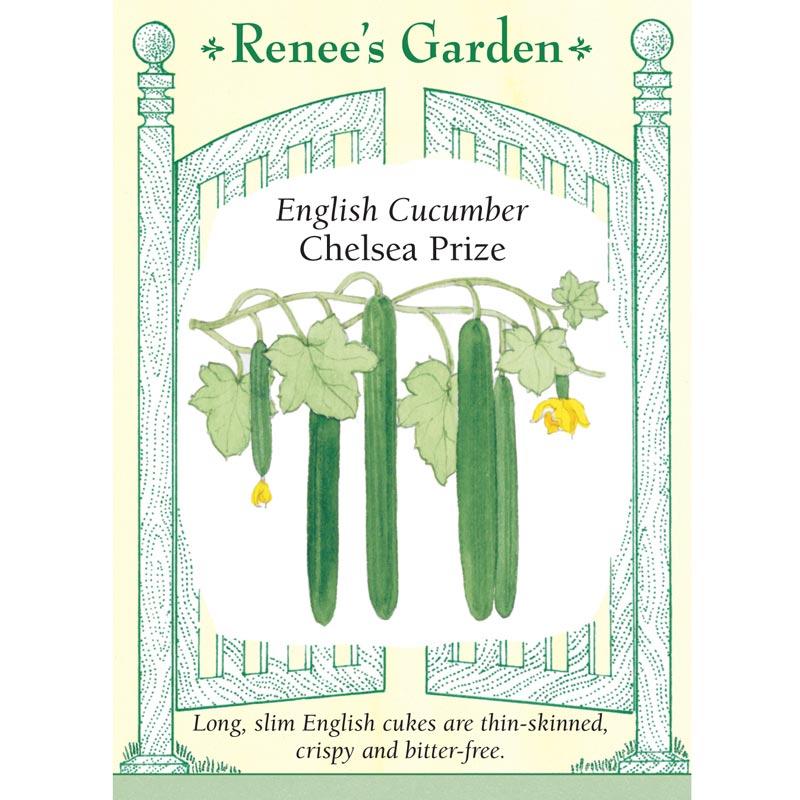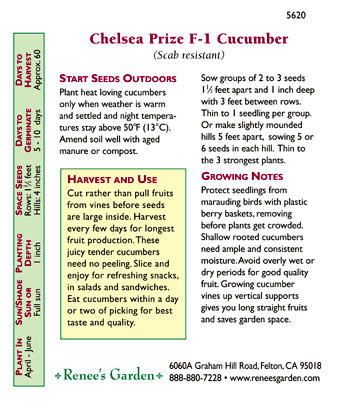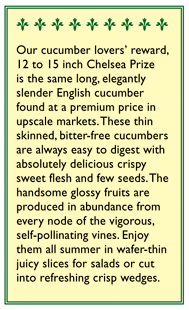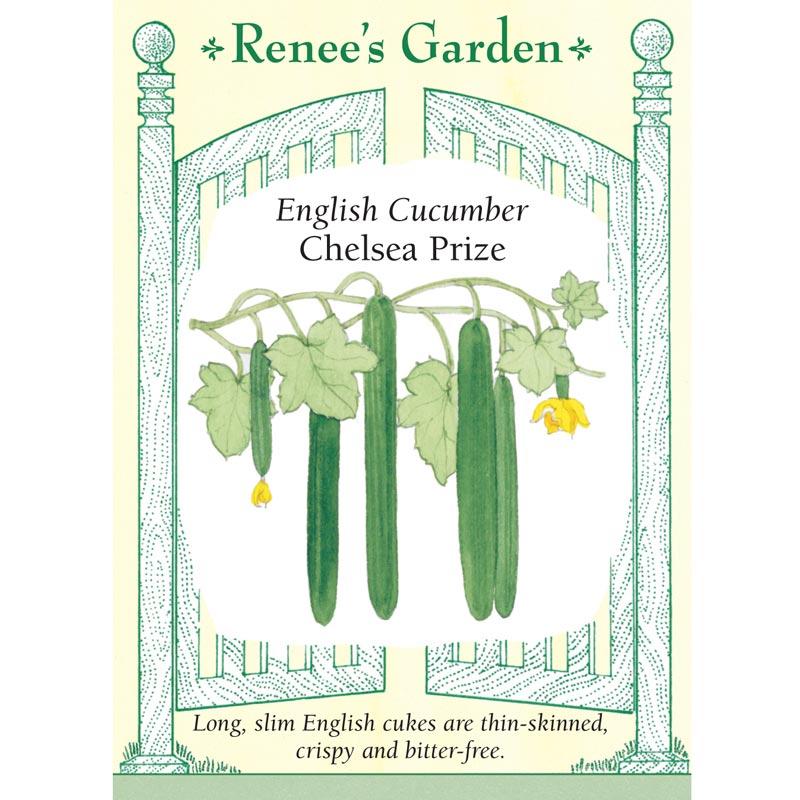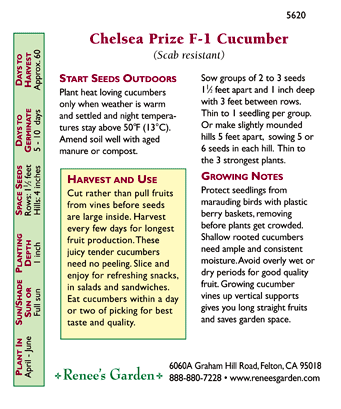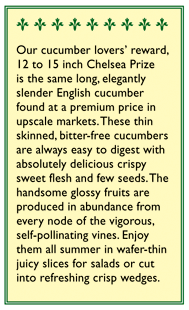Item Number: SNV5620
Chelsea Prize English Cucumber Seeds
Chelsea Prize English Cucumber Seeds
Bitter-free Slender English Cucumbers
Cucumbers, favored for their refreshing taste and versatility in the kitchen, are a delightful addition to any garden. Cultivating these vegetables involves a blend of patience, care, and attention to detail. There are various types of cucumbers to consider, each with its unique traits and preferences, making the growing process an exciting venture.
Days to harvest; 60(Hybrid) Exclusive - elegantly slender, thin-skinned English cucumbers with absolutely delicious, crispy sweet flesh. Easy to digest. Self-pollinating, vigorous vines. Growing cucumber vines up vertical supports give you long straight fruits and saves garden space. (60 days) Approximately 12-14 seeds.
Understanding Different Types of Cucumbers
Slicing Cucumbers: Known for their use in salads, sandwiches, and garnishes, slicing cucumbers typically have a crisp texture and are ideal for fresh consumption.
Seedless Cucumbers: These varieties are favored for their tender, seedless flesh, making them perfect for salads or snacking without the distraction of seeds.
American Cucumbers: A broad term encompassing multiple cucumber cultivars that are grown in different American regions, each with its distinctive features and adaptations.
Hothouse Cucumbers: Grown in controlled environments such as greenhouses or hothouses, these cucumbers are cultivated year-round, ensuring consistent quality and availability regardless of the season.
Cultivation Basics for Cucumbers
Sunlight and Soil: Cucumbers thrive in full sunlight, requiring well-draining, nutrient-rich soil. Ensure the soil pH is slightly acidic to neutral (6.0 to 7.0).
Planting: Sow cucumber seeds directly into the ground or start with seedlings after the danger of frost has passed. Maintain appropriate spacing between plants to facilitate healthy growth.
Watering: Consistent and adequate watering is essential, particularly during flowering and fruiting stages. Avoid water stress to prevent bitter-tasting cucumbers.
Fertilizing: Enrich the soil with balanced fertilizers or compost to provide essential nutrients for robust growth and fruit development.
Supporting Cucumber Plants
Trellising: Consider setting up trellises, stakes, or cages to support the cucumber vines. This helps prevent fruit contact with the ground and promotes healthier growth.
Pruning: Regularly prune or remove damaged leaves and stems to improve air circulation and prevent diseases.
Pest and Disease Management
Pests: Watch out for common cucumber pests like cucumber beetles, aphids, and spider mites. Consider natural or organic pest control methods to protect the plants.
Diseases: Be vigilant for diseases such as powdery mildew or bacterial wilt. Select disease-resistant cucumber varieties to reduce the risk of infections.
Harvesting and Storage
Harvesting: Cucumbers are typically ready for harvest in 50-70 days after planting. Pick them when they reach the desired size, encouraging further fruit production.
Storage: Store unwashed cucumbers in the refrigerator to maintain freshness. Use them within a week for optimal taste and texture.
Check Your Zone Compatibility:
Compatible with your zone.
Growing Zone for
,

Our Guarantee To You
Since 1976, we've served our customers at every stage of growing. Please contact us at any time. We are happy to support and assist you.
Description
Description
Cucumbers, favored for their refreshing taste and versatility in the kitchen, are a delightful addition to any garden. Cultivating these vegetables involves a blend of patience, care, and attention to detail. There are various types of cucumbers to consider, each with its unique traits and preferences, making the growing process an exciting venture.
Days to harvest; 60(Hybrid) Exclusive - elegantly slender, thin-skinned English cucumbers with absolutely delicious, crispy sweet flesh. Easy to digest. Self-pollinating, vigorous vines. Growing cucumber vines up vertical supports give you long straight fruits and saves garden space. (60 days) Approximately 12-14 seeds.
Understanding Different Types of Cucumbers
Slicing Cucumbers: Known for their use in salads, sandwiches, and garnishes, slicing cucumbers typically have a crisp texture and are ideal for fresh consumption.
Seedless Cucumbers: These varieties are favored for their tender, seedless flesh, making them perfect for salads or snacking without the distraction of seeds.
American Cucumbers: A broad term encompassing multiple cucumber cultivars that are grown in different American regions, each with its distinctive features and adaptations.
Hothouse Cucumbers: Grown in controlled environments such as greenhouses or hothouses, these cucumbers are cultivated year-round, ensuring consistent quality and availability regardless of the season.
Cultivation Basics for Cucumbers
Sunlight and Soil: Cucumbers thrive in full sunlight, requiring well-draining, nutrient-rich soil. Ensure the soil pH is slightly acidic to neutral (6.0 to 7.0).
Planting: Sow cucumber seeds directly into the ground or start with seedlings after the danger of frost has passed. Maintain appropriate spacing between plants to facilitate healthy growth.
Watering: Consistent and adequate watering is essential, particularly during flowering and fruiting stages. Avoid water stress to prevent bitter-tasting cucumbers.
Fertilizing: Enrich the soil with balanced fertilizers or compost to provide essential nutrients for robust growth and fruit development.
Supporting Cucumber Plants
Trellising: Consider setting up trellises, stakes, or cages to support the cucumber vines. This helps prevent fruit contact with the ground and promotes healthier growth.
Pruning: Regularly prune or remove damaged leaves and stems to improve air circulation and prevent diseases.
Pest and Disease Management
Pests: Watch out for common cucumber pests like cucumber beetles, aphids, and spider mites. Consider natural or organic pest control methods to protect the plants.
Diseases: Be vigilant for diseases such as powdery mildew or bacterial wilt. Select disease-resistant cucumber varieties to reduce the risk of infections.
Harvesting and Storage
Harvesting: Cucumbers are typically ready for harvest in 50-70 days after planting. Pick them when they reach the desired size, encouraging further fruit production.
Storage: Store unwashed cucumbers in the refrigerator to maintain freshness. Use them within a week for optimal taste and texture.
Planting and growing information can be found on the seed packet image. While Renee's Garden seeds are not all certified organic, they do not sell treated or GMO seeds and have signed the "Safe Seed Pledge". This seedline features unique varieties personally selected by Renee Shepherd for use in the kitchen or in bouquets.
Shipping Information
Shipping Information
Shipping Weight: 0.01 lb
Dimensions: 4.5"L x 3.125"W x 0.1"H
Features
Features
- Grow on a Trellis
- Hybrid
Characteristics
Characteristics
Planting & Care
Planting & Care
Soil & Water: Amend soil well with aged manure or compost. Ample and consistent moisture is required. For good results avoid overly wet or dry periods.
Planting & Growing: Wait until weather is warm and settled and night temperatures stay above 50 degrees. Sow groups of 2-3 seeds 1 inch deep and 18 inches apart with 3 feet between rows. Thin to 1 per group. Hill planting can be done sowing 6 seeds per hill each hill 5 feet apart. Thin to 3 strongest plants.
Harvesting & Storage: Cut fruits from vines before seeds are large inside. Harvest every few days for longest production. Eat within a day or two of picking for best taste and quality.
Useful Information
Useful Information
Guarantee
Guarantee
Share
